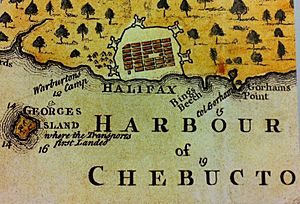John Gorham (military officer) facts for kids
Quick facts for kids
John Gorham
|
|
|---|---|
| Born | 12 December 1709 Yarmouth, Barnstable County, Massachusetts |
| Died | December, 1751 (aged 41–42) London, England |
| Allegiance | Massachusetts Bay Colony; England |
| Service/ |
Ranger |
| Rank | captain (of Independent Company in the British army); lieutenant-colonel (in Massachusetts provincial forces) |
| Commands held | Gorham's Rangers 1744–1751, and 7th Massachusetts Provincial Infantry Regiment--second in command (1745), acting commander (1746) |
| Battles/wars | King George's War
|
| Other work | representative |
John Gorham (born December 12, 1709 – died December 1751) was an important military leader from New England. He was a Ranger, which means he was part of a special group of soldiers who were skilled at fighting in the wilderness. Gorham was one of the first British military leaders to stay in Nova Scotia and Acadia for a long time after the British took control of the area in 1710.
He created a famous group of soldiers called "Gorham's Rangers." He also had two armed ships, the Anson and the Warren, which helped patrol the waters around Nova Scotia. John Gorham was active during two major conflicts: King George's War and Father Le Loutre's War.
Contents
Gorham's Military Career
John Gorham started his military career in June 1744 as a captain in a local army company. By February 1745, he was promoted to lieutenant-colonel. Two years later, in 1747, his unit became part of the regular British Army, and he became a captain in an independent company.
Sometimes, people confuse him with his father, Shubael Gorham, who was also a provincial colonel during King George's War. John Gorham was one of only a few American rangers who earned a high rank in the British Army. His younger brother, Joseph Gorham, also became a famous ranger.
The Gorham Family's Ranger History
The Gorham family had a long history of serving as rangers. This tradition began with Benjamin Church, a famous ranger leader. John Gorham I, an ancestor, died fighting alongside Church in a battle called the Great Swamp Fight. The towns of Gorham, Maine and Gorham, New Hampshire are named after him.
John Gorham II, another family member, also served with Church during an expedition into Acadia. This included the Raid on Chignecto (1696) during King William's War. John Gorham's father, Shubael Gorham, was also an important officer. He commanded a regiment during the Siege of Louisbourg (1745). Our John Gorham and his brother Joseph continued this family tradition, serving as rangers in Acadia.
British Control in Nova Scotia
Even after the British took control of Acadia in 1710 and signed a peace treaty in 1713, they struggled to fully control Nova Scotia. John Gorham and his Rangers arrived to help the British expand their influence beyond just defending Annapolis Royal and the fishing village of Canso. Gorham helped the British go on the attack during King George's War.
King George's War
Defending Fort Anne (1744)
During King George's War, Gorham and his company of Native American rangers from New England helped defend Fort Anne from attacks. These attacks came from French, Acadian, and Mi’kmaq forces. During the Siege of Annapolis Royal (1744), on October 4, Gorham's rangers attacked Mi'kmaq people in nearby wigwams. The governor at the time, Mascarene, noted that the New England Rangers' fighting style was very effective.
In February 1746, Governor Shirley wrote that Gorham’s Rangers were very helpful to the fort at Annapolis Royal. He said their actions showed how useful such a group of soldiers could be.
Siege of Louisbourg (1745)
Gorham fought alongside his father during the Siege of Louisbourg (1745). This was a major battle where the British captured the French fortress of Louisbourg. Sadly, his father died shortly after the siege, likely from natural causes.
After the siege, Gorham was given a special job to defend Nova Scotia. In 1748, he was in charge of Gorham's Independent Company of Rangers. Many Wampanoag people were part of this company, which was based in Nova Scotia. In the autumn of 1748, Gorham helped stop Acadian resistance in an area called Minas. He then sailed to the Saint John River to end Acadian and Maliseet resistance there.
Father Le Loutre's War
Soon after Governor Edward Cornwallis arrived in Nova Scotia in July 1749, John Gorham was appointed to the Nova Scotia Council. This was a group that helped govern the area. In 1749, during Father Le Loutre's War, Gorham helped build Fort Sackville in what is now Bedford, Nova Scotia. Gorham used this fort as a base for his operations.
Gorham also took part in the Battle at St. Croix and the Battle at Chignecto. He served on the Council for two years. In August 1751, Gorham left Nova Scotia and traveled to England. He died in London in December 1751 from smallpox.
Legacy
- A street in Bedford, Nova Scotia, called John Gorham Lane, is named in his honor.
See also


